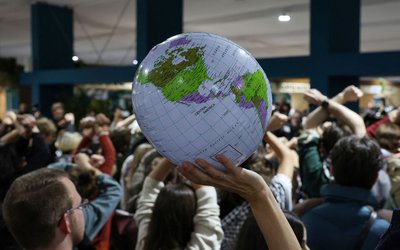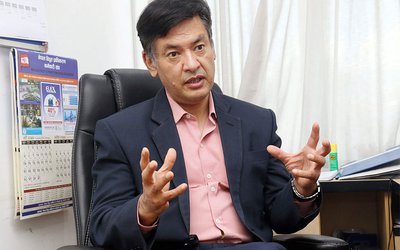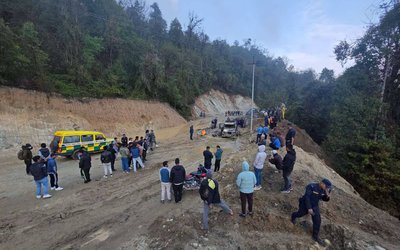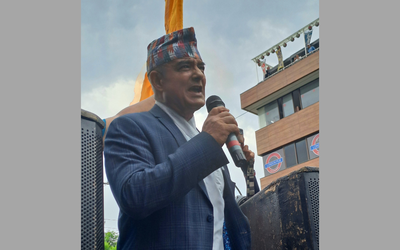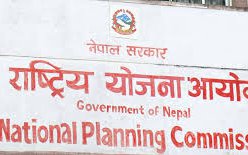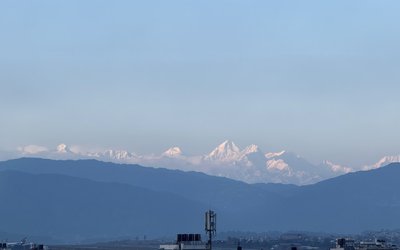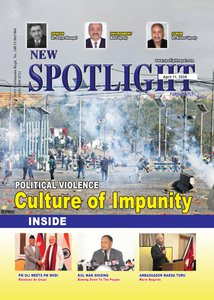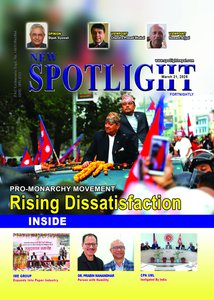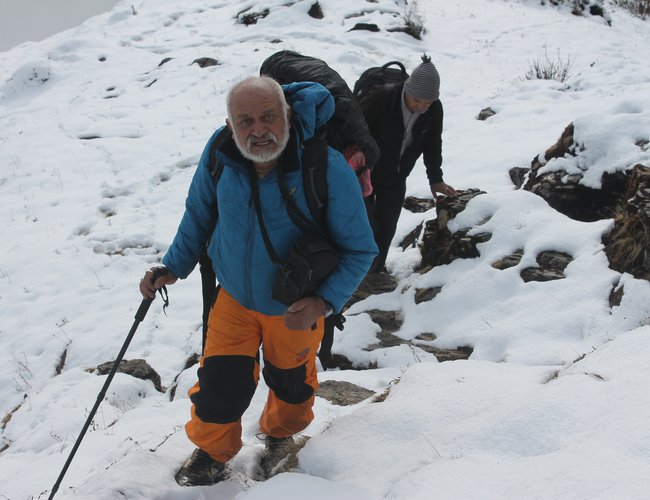
Nepal is a Shangri-La destination for all trekkers. The country's tourism treasure has not been fully explored yet, with many hidden mysteries waiting to be discovered. Natural gifts, panoramic landscapes, man-made heritages, ethno-cultural richness, innocent social settings, hospitality, and many more unexplored treasures are dreams for tourism enthusiasts (Sharma 2005:1). Tourism in Nepal is a key development component and will remain a significant sector for overall sustainable development. Rural tourism in Nepal is a complex, multi-faceted activity that includes special nature holidays and eco-tourism, such as walking, climbing, horse riding, adventure sports, bungee jumping, health retreats, hunting, angling, educational travel, arts, heritage, and in some areas, ethnic tourism (Pandey 2005: 23).
Despite this, Nepal is often only visited for a few well-known destinations such as the highest peak in the world, Mt. Everest, the birthplace of Gautam Buddha, Lumbini, and the cultural museum of the Kathmandu Valley - the ethnic crossroads of Asia (Hagan, 1961 in Sharma 2005:1 “The Inclusive Democracy” an unpublished article). However, there are places that cater to tourists of all interests that should not be missed. Nepal, the cheapest destination with the highest hospitality, can accommodate tourists from all over the world.
Nepal is a melting pot for visitors from across Asia, especially to the richest and most mysterious destinations - China, India, the Hindukush range, and the Pacific areas. Tourism, as a sustainable industry, has attracted people from all over the world (Kunwar 1997: acknowledgements). Therefore, spending a few days in Nepal can provide an opportunity to explore the natural beauty of the world. Among the various travel packages to Nepal, trekking is considered the most adventurous and enchanting. Treks around Annapurna, the Khumbu region, Kanchanjunga, Rolwaling, Langtang, Simikot-Mansarobar, Upper Mustang, Dolpo, etc., are unique destinations. Additionally, a two-day trek from Khalanga-Jumla to Rara Lake-Mugu offers a tremendous experience and new insights on the horizon.
The Journey to Jumla- Rara
A trekker can board a twin otter from Nepalgunj or Surkhet to Jumla. The experience of the plains (Terai) with the hot climate of Nepalgunj may be similar to that of Surkhet valley, the headquarters of Karnali Pradesh. The take-off of the plane gradually leaves the flat land and climbs up through the Chure jungle, offering views of the Surkhet valley with scattered settlements on the red-colored landscape and the winding bends of the Bheri river and its tributaries. Within 12 to 15 minutes of flight from the Terai, the topographic diversity changes the perspective of the passengers on board. Peering out the window for about 5 minutes over Surkhet valley, the aircraft passes above Dailekh District or Jagarkot (to your right). The journey continues with views of the Karnali river meandering through rural settlements, glimpses of the Surkhet-Jumla road along the riverbank, and transitions from lowland to upland terrain - hills, villages, barren hills, jungles, streams, and isolated lands. The plane ascends in altitude, leaving Surkhet valley and Dailekh district behind, heading towards Kalikot (to your left), a mountainous district in the hills. Kalikot is known as the most inaccessible and remote district among the 77 districts of the kingdom (Khadka 20056 BS).
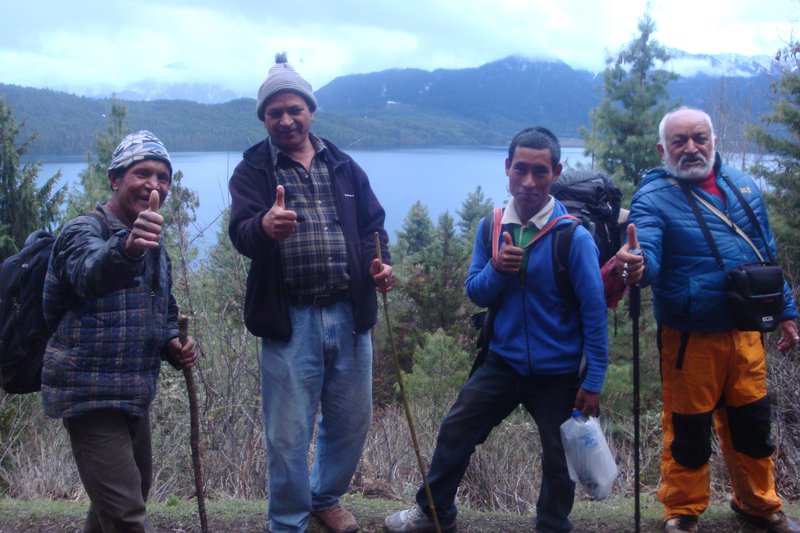
The terrace settlement, vertical hills with sparse villages, gorges of the rivers, green hills, laligurans (Rhododendron), sometimes you will narrowly view rocky mountains, the sheds of sheep and cows; some Kharkas (seasonal pasturage) with thatched huts, gothalas (cowboys) and so forth.
The Gorge of Karnali River
When you approach the border of Jumla district, you will be narrowly passing through very exciting mountains - Haodelek where few foot-trekkers to and from Jumla-Surkhet are climbing up or down. Then your aircraft will follow the bank of the Karnali River toward the Jumla region. Close to the hill on your left side, you will be looking down the gorge of the Karnali River and high green mountains on your right side or left. Now your plane descends to Khalanga (open valley) above Talium, Bohara gaon with flat clay roofs clustered settlement and Khalanga (Chandannath municipality) - the headquarters of Jumla as well as the then Karnali zone. Your plane slightly tilts to the left side over Chandannath and finally lands on Jumla airport. This ends your thirty-five minutes’ air journey. When the Surkhet-Jumla road construction is completed, the journey is a different one and a different experience, i.e., traveling by bus.
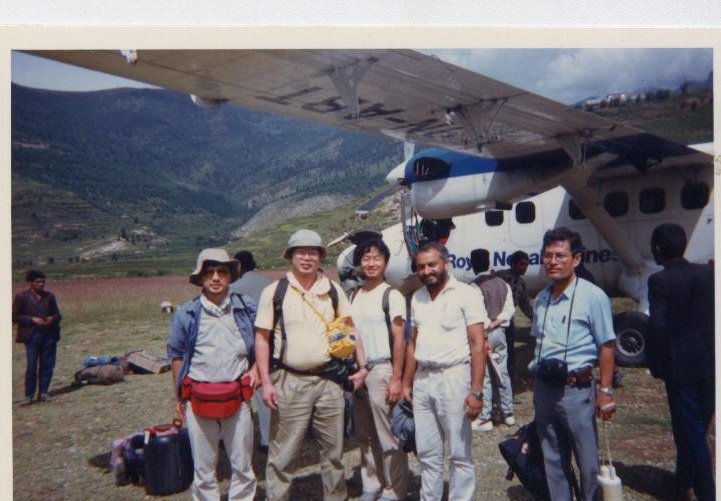
The arrival at Jumla Airport
Jumla Khalanga
Stay one day in Jumla Khalanga and prepare for the journey to Rara the next day. Visit Chandannath temple, chat with Jumli people, and enjoy Jumli Rajma and apples if it is autumn. Buy necessary trekking foods, hire a porter and a guide cum-cook since there are no good hotels or lodges along the trekking route. Collect all necessary goods, foodstuffs, sleeping bag, etc. A movie camera or camera with a good lens is a must. If you are all set, ask for blessings from Chandannath and head towards Danfekolek, a steep climb to the sky!
The next day from Khalanga, proceed to Jumla campus and Technical Institute, a vocational training school roofed with high-quality local slates. Continuing past the technical institute, you will pass through a meadow (Chyare Chaur) where sheep, horses, and cows graze. Take some time to chat with the shepherds/cowboys for about half an hour. Then, as you head towards the foothill of Danfekolek, enjoy easy walking similar to your hometown or resident area. Take a break to enjoy fresh water, rest, and have some light snacks. Begin the steep climb up Danfe hill, reaching about 4300 meters.
Follow the curly track, take short pauses (rest) every 10 to 15 minutes. Enjoy the view of green meadows, the technical institute in the distance, and a partial view of Khalanga bazaar and government office buildings. When you encounter locals coming from the other side, you can ask them how far the top is or when you will reach Tharmare, a rest café beyond the Danfe peak. This interaction will give you hope, relaxation, and insight into the behavior of local people. For the climb up the hill, it is recommended to have a pack of glucose biscuits with local water, chewing gum, or at least some polo candies purchased in Nepalgunj or Khalanga. After about one and a half to two hours, you will reach the top of the Danfe pass. Take a break at the Chaupari (rest spot) for about an hour, enjoy the view of the high mountains, the Khalanga valley, and the surroundings. Take a few photos at this spot. You may experience slight suffocation due to the high altitude, which is about 14,000 feet.
If you are feeling tired, enjoy some light snacks before moving ahead towards Tharmare. Once again, you will walk through another meadow called Khalichaur, a fantastic solitary place for camping and hiking. Here, you will find cattle grazing - sheep, ponies, yaks, and cows. However, there are no signs of human settlement, such as houses, farms, or villages. You are completely surrounded by nature, with the blue sky above you and the jungle and grassy land around you, along with the chirping sounds of birds. If you are lucky, you may spot the Danfe, the national bird, and the usual sight of cattle grazing in the distance. If you are interested in learning more about the Kharkha, a seasonal pasture, spend a day with the shepherds (gothalo) who may be with the cattle under a big tree, inside a plastic tent, or under a cave. You will find them either knitting woolen or alpaca thread, weaving woolen blankets such as radipakhi, lieu, kamlo, and their own garments, or playing cards, smoking attar (ganja), and hukka (local smoke). They spend about 5-6 months living this way, and when autumn arrives, they come down to their settlements or to the lowlands. In spring, they return to the Kharka. This is their usual life cycle, which is also found in other parts of Jumla and Mugu districts.
Caravan of Yak and Goat
After a half-hour walk, you will reach the Tharmare shed (café) where you will be served black tea, biscuits, chow mein, and sometimes local mutton. Thar refers to blue sheep or wild goats, which used to be hunted by the locals in this area. After enjoying your hot black tea or chow mein at the Tharmare Bhatti (café), you will need to pass through the jungle and descend to Neurigadh brook, which will take about an hour. There, you will find around a dozen houses with a few tea stalls. If you arrive around 3 o’clock and are not too tired, you can continue up to Kabra and stay there. Otherwise, spend the night at Neurigadh as Kabra only has a single tea stall and no other accommodations. The tea stall owner will provide you with dhulo (roti) and a fresh green vegetable dish mixed with highland potatoes, which is tasty and unique. If you have your own plan, bring a tent and set it up with your trekking team. The next day, wake up early, have tea and breakfast, and continue your trek to Chautha.
On the way, you will find a few primitive types of settlements with a few tea stalls. You have to go straight, neither climbing up nor down. Chautha is a junction to Sinja and Mugu destinations. There are a dozen houses and more than one Bhattis. Food items may be more abundant, and the quality of food and shelter is better there. A visit to Sinja, a historically important place for humanities development, such as the Nepali language and tribal expansion, will have a separate chapter of trekking. It was the capital of Nepal from the rule of Nagraj in Karnali up to the Challa dynasty in medieval Nepal (Khadka 2056 BS: 168).
Rest on the top of Ghuchhiko Lek
After spending an hour and a half at lunchtime, you climb up to Bhulbhule army camp, the Ghuchhiko Lek. Climbing through the jungle of pine and Bhojpatra trees, you will be surrounded by the natural beauty with no signs of human settlement. During the hour-long climb, you will be immersed in nature - steep rocks, century-old forests, the chirping of birds, murmuring brooks, and towering trees. Now you are in Rara National Park, where you may have the chance to spot Danfe, wild boar, bear, and leopard. Before reaching the top of Ghuchhiko Lek, you will come across a few Bhattis in Bhulbhule where about half a dozen houses serve light snacks. This is the last Bhatti, so take a rest there for at least half an hour and enjoy black tea with your light snacks, perhaps biscuits. Don't forget to try the local potatoes. Then, climb for another half an hour until you reach a large meadow (Guchhi Chaur) or Kharka (Gothi Chaur) where you will see grazing cattle and a few tents of the Gothalos (shepherds). Turn left here, leaving the path that leads to Ghuchhi lek (pass) for Rara Lake. Proceed from Chuche Mara Lek (possibly a bore hunting area).
You have another option as well. Follow the Ghuchhi lek and descend to Pina-Jhyarigaon to reach Rara Lake. Walk straight through the jungle of the national park for about three hours, and you will arrive at the Rara area, located at the northern corner of the lake. The third option is via Gumgadhi. There is a single Bhatti on the west side of the lake next to the Nepal Army camp, specifically stationed for the security of Rara National Park. Directly opposite this spot, on the east side of the lake, you can see a plain land where the late King Mahendra used to camp and write a few poems. Therefore, Rara is also known as Mahendra Tal. The lake resembles: #
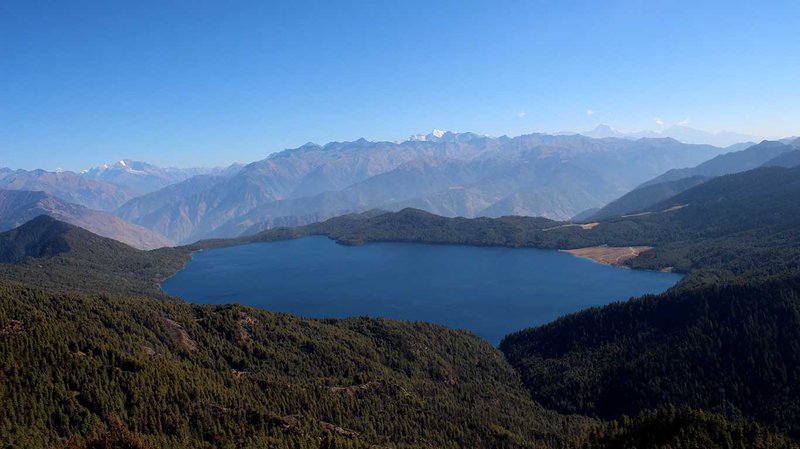
Rara Lake
Reflection of Kagmara Mountain range in Rara Lake
Stay in the guest house or camp for two days. It can accommodate about 120 tourists per day. There are two guest houses available. While exploring the lake, be cautious of wild boars and bears as they frequently visit the lakeside, and encounters can happen. To the west of the lake, there is a temple nearby and a wooden bridge over the outlet water of the lake.
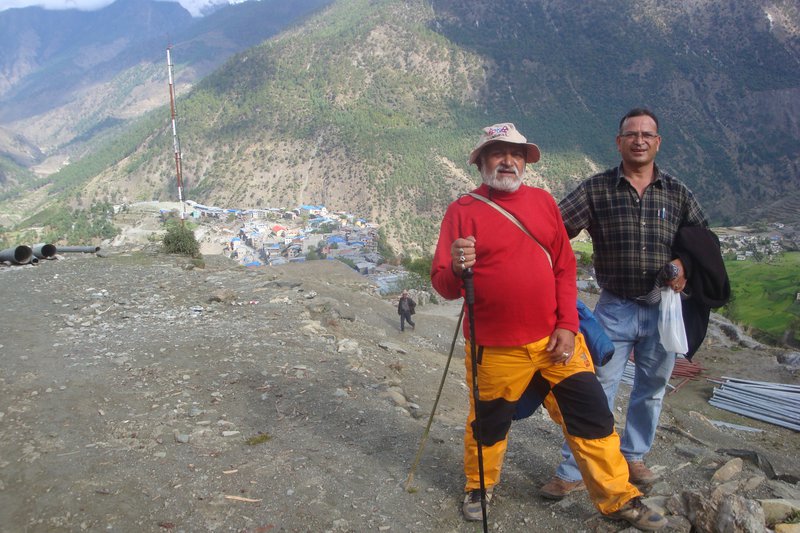
Rara Lake is the largest lake in Nepal. The clear blue water reflects the Kagmara Mountain range, Murma top, and other surrounding hills. Under the subsidy of SAPROS-Nepal, an NGO, a goose farming project was initiated. To learn more about the facts and wildlife as well as natural phenomena, you can be briefed by the Nepal Army or locals who may be there for firewood and grass collection, or some may be with their cattle. You can see fish in the shallow water, but fishing is not allowed as it is within a national park. Boating for about half a day is a must. You can circle from North to South and East to West to enjoy the enchanting panorama of Rara Lake. There are three rowing boats, including a motorboat, which can be hired for a nominal charge of Rs. 500 for Nepalis and Rs. 1500 for foreigners. However, locals do not have to pay.
The Possibility of Encounter with Wild Animal
A visit to Rara National Park can be a separate destination, but trekkers can enjoy most of the park while trekking up and down from Chautha to Rara Lake. A person who visits Rara must also visit Murma Top; otherwise, the Rara trek is incomplete. When you reach the top, you will see the paradise of Nepal - from the Himalayas to the green hills around you. Rara Lake is perched on a high shelf at 2980m and is protected by Rara National Park, established in 1976. The park covers an area of 106 sq. km and is the most popular trekking area in the far west. Rara Lake, 5 km long and 2 km wide, is Nepal's largest lake. Its shimmering blue waters, reflecting Gurchi Lekh's snowy peaks, are surrounded by meadows and alpine forests. The park is a birdwatcher's delight, especially during November and April when ducks, cormorants, and other birds visit during their seasonal migration.
The Rara National Park Office
The next day, you can climb up Murma top on foot or by horse ride, from where you can overlook the immediate five districts - Humla, Kalikot, Bajura, Acham, and Jumla. It is a nice place to stay for about an hour and enjoy the natural beauty, where you may feel as if you are lost in a dream of heaven, like poet William Wordsworth or the late king Mahendra. Everywhere you will see green forests and in the distance, white-topped mountains and the sounds of nature. Murma top can touch the heart of every human being. Your camera will be half exhausted at the top. The author of this article recommends that all tourists visit Rara destination, especially in the autumn season. Another way to visit only Rara Lake is by air service directly to Talcha airport, from where you can take a pony ride or travel for about two hours to Rara National Park. Additionally, if you have a long trekking mission, you can go to Kailash Mansarovar for about a two-week trek. I have not mentioned much about the unique places, things, and insights of the Jumla-Rara trek because visitors will discover and explore the unexplored mysteries of the destination themselves. Therefore, the article is also unexplored.

Gumgadi, the capital of Mugu
On the way back, the trekker can collect new experiences and scenes and sights with local products. Despite this, the author would like to draw the attention of the concerned stakeholders - the Nepal government, tourism entrepreneurs, local governments, and locals of that destination to come up with a new vision, plan, and program to exploit the vast potential of this region. Thus, the Jumla-Rara trek is one of the wonderful adventures in the Karnali region. It is the gateway to explore the hidden treasures of the Karnali region and can bring prosperity to the people living in poverty.
Prof. Prem Sharma. PhD Former HOD, CDRD, TU
References
Sharma, P. “The Inclusive Democracy”, unpublished article 2006.
_______. 2005. “Village Tourism for the Sustainability of Rural Development” Prospect of village tourism in Nepal. Kathmandu: Village Tourism Promotion Forum- Nepal.
Hagen, T. (1961). Nepal: The kingdom in the Himalayas. Berne, Switzerland: Kummerly and Frey.
Khadka, R. (2056 BS). Karnali. Kathmandu: Media Service Nepal.
Kunwar, R. R. (1997). Tourism and Development. Kathmandu: Laxmi Kunwar.
Hagen, Tony. (1961). Nepal: The kingdom in the Himalayas. Berne, Switzerland: Kummerly and Frey.
An interview with Khadak Shahi and Chandr Bahadur Shahi (MP) of Mugu. 13-14 July 2006.
Pandey, R. J “Rural Tourism in Nepalese Perspective: Challenge to Make it Sustainable and More Pro-poor”, Sharma, Prem, (Ed.) (2005). Prospect of Village
Tourism in Nepal. Kathmandu: Village Tourism Promotion Forum- Nepal.
Pandey, R. (1984). Nepal Parichaya. Kathmandu. A. Pande.
Internet website: www.google.com
The author owes to L. B. Yadab, Dipenrda Paudel, Dr. Soorabeera Paudel for the photographic.
- Rafting In The Karnali River
- Aug 31, 2024
- Religious Cultural Potentiality of Tourism in Humla
- Aug 18, 2024
- Elderly Abuses And Challenges Of The Day
- Jul 31, 2022
- No Politics And Good Voters For (Local) Development
- Jul 06, 2022



